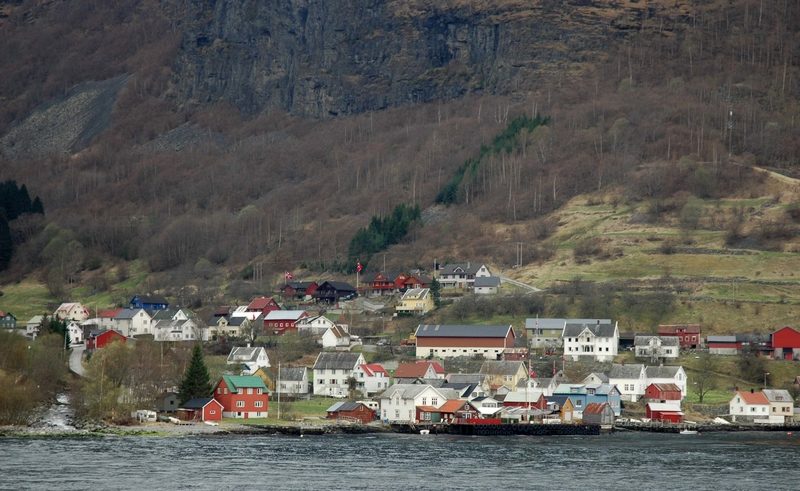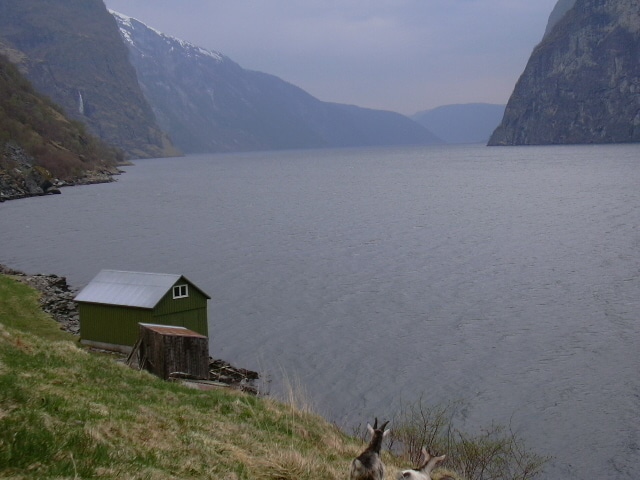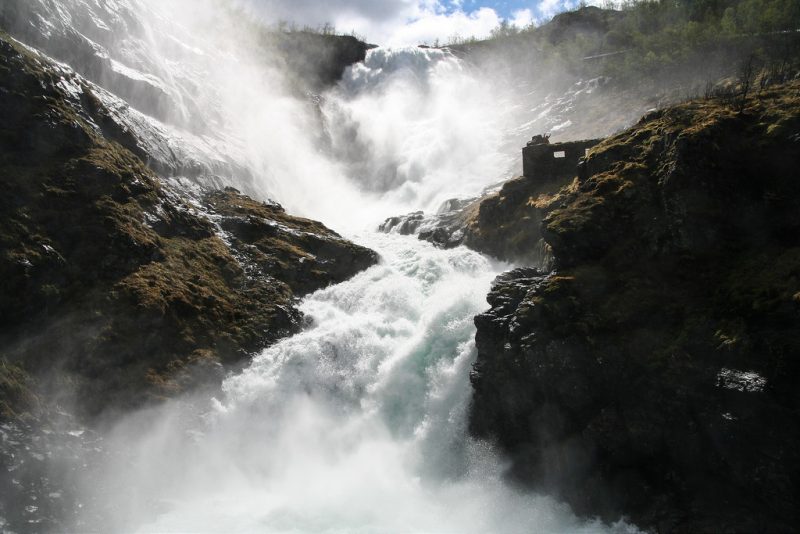
There is a slight chance that the Flåmsbana, the Norwegian railway connecting the villages of Myrdal and Flåm, might not be the steepest of the world. But don’t ever say it out loud in front of someone from Norway. The truth is that the record might belong to the Pilatusbahn, in Switzerland.
The Swiss trains run on a rack railway, whereas the Flåmsbana trains run on a regular line and reach a maximum gradient of 5.5% without the support of a rack-railway system that makes things easier for the Pilatusbahn in Switzerland. So there you have it: the Flåmsbana is, all things considered, the steepest railway line in the world.



I hear the full story from the Norwegian woman sitting in front of me: we have just left Bergen on a train that will end its journey in Flåm, a small village on the innermost part of the Aurlandsfjord. The chatty lady reminds me that I should get off at Myrdal and wait for the connecting train: before I even ask her, she starts explaining that Myrdal is the Flåmsbana starting point.The journey from Bergen to the connecting station is nothing special, according to the woman: it is a plain local train. But things change at Myrdal, she says. I close my book shut, giving up the idea of reading what Jo Nesbø has in store for Harry Hole, and smile at the woman whose name I didn’t get. I nod here and there, asking questions about the journey ahead. She will get off at Voss, where she lives. I’d rather sit and enjoy the passing landscape through the window, but she has different plans and keeps talking. We arrive at Voss, she says goodbye and walks away; when another passenger takes her seat, I pretend to be engrossed reading my book.
Looking through the window I realize how the landscape is changing rapidly: when I left Bergen in the morning, the autumn colors were brown and dark green; now everything is turning grey and white.
When the train stops at Mjølfjell, a small station at about 2,000 feet above sea level, there’s snow along the platform. When I get off at Myrdal, the snow is as high as the main building window sills. The wind is chilly, and the air is much colder than it was when I left Bergen a couple of hours ago. Passengers move swiftly, getting on trains bound somewhere else. I join a group of people who are looking lost, trying to understand where to go next. A conductor comes to our rescue and tells us – in a heavily accented English – where to wait for next Flåmsbana train. Not that one might risk getting lost at Myrdal station, with two tracks and a handful of wooden buildings painted red. I walk along the platform, wishing for the train to arrive soon, and in the meanwhile I look around and take in the landscape.

There’s nothing but the mountains and the buildings of the station: before getting off at Voss, the chatty woman told me that Myrdal cannot be reached by car as there are no roads. I had asked her whether there were people living in the village and apparently there are just a couple of summer cabins and a few inns. I hope that Flåm, my final destination, will be less isolated.


As soon as the train approaches and stops at the platform I get in the first carriage, hoping that it will be warmer inside. It feels like stepping back in time: the moss-green carriages belong to another era, as well as the brass handrails running along the red, velvety backrests. It all looks outdated and impossibly charming. We all look like a group of children on a school trip: some touch the thick velvet coats of the seats, some takes pictures of the wooden partitions, and some try to open the windows.When the train slowly leaves the station I can’t wait to see what comes next: in under an hour we will cover a 2,600-feet downhill in just 13 miles. We will slowly descend towards the terminus. The chatty woman had also mentioned another record of this railway line, that is, its number of tunnels. They were excavated by hand back in the time when the Flåmsbana was built in order to connect the Oslo-Bergen train route to the Aurlandsfjord, one of longest fjords of the country.
For the first few miles, the train runs in and out of tunnels, and we can barely glimpse at the small waterfalls pouring down from mountains tops and at the small wooden houses painted in bright colors and standing out against the snow. I wonder whether there are people living there or whether the cabins with their sloping roofs have been placed there just for the Flåmsbana passengers to look at.
I will never know the answer and I forget about it when the train stops abruptly after a long tunnel. The conductor says something in his charming Norwegian lilt, then in English: we are allowed five minutes. I don’t know what for: all I can see from the window is the mountain rock and a corner of the platform outside. There can’t be a station in the middle of nowhere, can it? We are at a loss, but finally a brave American guy pushes open the carriage door and gets out.


Meanwhile, a group of more adventurous passengers have taken out their cameras and are taking pictures of the Kjosfossen. With a drop of about 330 feet, it is the highest waterfall of the country. It is accessible only through the Flåmsbana, and its extreme isolation certainly helps making the scenery even more breathtaking. Being on small wooden runway, with a green train behind our backs and a waterfall erupting from the mountain in front of us leave everyone speechless. Well, nearly everyone because one of the passengers is complaining. Or maybe he’s just showing off. Apparently he has been here before, during the summer, when the snow on the mountains melts down and makes the waterfall bigger and more powerful. He seems to be very knowledgeable and assumes that most of the water has frozen as a result of the cold weather of the past few days. It doesn’t really matter, honestly: the view is spectacular and is certainly worth the trip, even this time of year. And anyway I have a good reason to come back during the summer.
We reach the terminus after ten minutes: the station at Flåm is nothing more than a couple of wooden buildings and a lonely dead-end platform. The trains cannot go anywhere; they can only go back,climbing the mountain, towards Myrdal. There isn’t much in this small village: a quay and the Aurlandsfjord in front of me, and the Fretheim Hotel on the right. It’s an ancient building, a former farm on the fjord’s shore where almost everyone will stay the night.

A couple of hours later it’s time to join other people for dinner at the Arven, the hotel restaurant. The menu varies according to the season and to what the local farmers can supply. As a starter, I choose the Skalldyrs suppe fra Sognefjorden (Sognefjord fish soup) and some fenalår, cured and smoked leg of lamb.
For dessert I try some Geitost, a goat’s milk cheese made in Undredal, another tiny village along the fjord. Geitost is brown, and its peculiar color is the result of the sugar naturally present in the milk turning into caramel. It looks a lot like fudge and tastes unusual, but it’s a product that one has to try in Norway: a thin slice of Geitost on warm brown bread is the perfect way to end your meal, and also gives you a head-start at breakfast.
The day ends in the most perfect way: sipping some aquavit, liquor made with potatoes, herbs and spices, and enjoying the view on the dark fjord outside.

